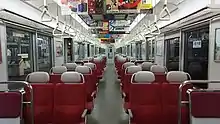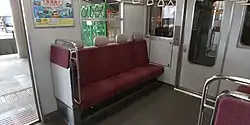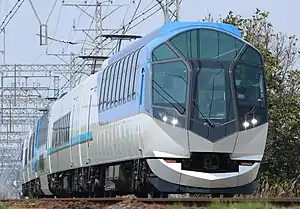Kintetsu 5800 series
The Kintetsu 5800 series (近鉄5800系), nicknamed the "L/C car", is an electric multiple unit (EMU) train type operated by the private railway operator Kintetsu Railway on standard gauge (1,435 mm (4 ft 8+1⁄2 in)) commuter services in the Kansai area since 1998.[2]
| Kintetsu 5800 series | |
|---|---|
 A 5800 series trainset | |
| In service | 1998–present [1][2] |
| Manufacturer | Kinki Sharyo |
| Number built | 46 vehicles (8 sets)[1][2] |
| Number in service | 46 vehicles (8 sets) |
| Formation | 4/6 cars per trainset |
| Fleet numbers | 5801–5805, 5811–5813[1] |
| Operator(s) | Kintetsu Railway |
| Line(s) served | |
| Specifications | |
| Car body construction | Aluminum alloy |
| Car length | 20,720 mm (68 ft 0 in) |
| Width | 2,800 mm (9 ft 2 in) |
| Height | 4,150 mm (13 ft 7 in) |
| Doors | 4 pairs per side |
| Maximum speed | 110 km/h (68 mph) |
| Traction system | Mitsubishi Electric |
| Power output | 165 kW per motor |
| Acceleration | 2.6 km/(h⋅s) (1.6 mph/s) |
| Deceleration | 4.0 km/(h⋅s) (2.5 mph/s) |
| Electric system(s) | 1,500 V DC, overhead line |
| Current collector(s) | Pantograph |
| Multiple working | 9820 series |
| Track gauge | 1,435 mm (4 ft 8+1⁄2 in) |
The series won the Laurel Prize in 1998 by the Japan Railfan Club for having the most innovative features for trains entering service that year.[3]
Overview
Perpendicular seating has long been provided on long-distance services on the Osaka and Nagoya lines.[1] In previous Kintetsu 2600 series trainsets and related counterparts, fixed perpendicular seats were a common feature on these services. However, passengers complained about their lack of comfort.[4]
In the early to mid-1990s, the railway began experimenting with seats that could change between longitudinal (perimeter) and transverse (row) seating configurations. In January 1996, A 4-car 2600 series set would be retrofitted with rotating seats.[1] During peak hours, the seats would be configured in the transverse configuration and then switch to longitudinal configuration during off-peak hours.[1] By March of that year, the experiment was deemed a success and the feature would be implemented onto trains being ordered for the long-distance services.[4]
The 5800 series trainsets would enter service in 1998 on the Osaka and Nagoya lines.[2] One 4-car train and seven 6-car trains would be produced. These would also be the last trainsets to feature the signature conventional body design introduced in 1984, as Kintetsu would switch to a new body and livery starting with the 21 series introduced in 2000.
The series is the first to be delivered with rotating longitudinal/transverse seating. Other private railways such as Tobu, Keikyu, Keio, and Seibu would later implement rotating longitudinal/transverse seating on future rolling stock additions.
As of 2021, the seat configuration on all Kintetsu trains equipped with rotating seats is dependent on the line and time of day.[1]
Formations
As of 1 April 2016, the fleet consists of seven six-car sets and one four-car set, formed as follows.[2]
Four-car set
The lone four-car set is allocated to Tomiyoshi Depot.[5]
| Designation | Mc | T- | M | Tc |
|---|---|---|---|---|
| Numbering | Mo 5800 | Sa 5710 | Mo 5600 | Ku 5300 |
Six-car sets
Six-car sets are allocated to Koan Depot and Saidaiji Depot, each with three sets.[5]
| Designation | Mc | T- | M | T- | M | Tc |
|---|---|---|---|---|---|---|
| Numbering | Mo 5800 | Sa 5700 type | Mo 5600 | Sa 5500 | Mo 5400 | Ku 5300 |
Interior




See also
- Seibu 40000 series, a Seibu Railway commuter EMU type that also features rotating longitudinal/transverse seating (some sets only)
- Tobu 50090 series and 70090 series, Tobu Railway commuter EMU types that also feature rotating longitudinal/transverse seating
- Keikyu 2100 series, a Keikyu commuter EMU type that also features transverse seating
- Keikyu N1000 series, another Keikyu commuter EMU type that also features rotating transverse seating (batches 20 and 21 only)
- Kintetsu 5820 series, a similar type with changing seat configurations operating for Kintetsu Railway, the curators of the design
References
- 三好, 好三 (2016). 近鉄電車 [Kintetsu Railway] (in Japanese). Japan: JTBパブリッシング. p. 91. ISBN 9784533114359.
- 諸河, 久 (1998). 日本の私鉄 近鉄2 [Japanese Private Kintetsu World (2)] (in Japanese). Japan: 保育社. p. 38. ISBN 978-4586509058.
- "1998年 ブルーリボン・ローレル賞選定車両" [1998 Blue Ribbon Laurel Award Selected Vehicle]. jrc.gr.jp (in Japanese). Archived from the original on 26 May 2022. Retrieved 10 December 2021.
- 近畿日本鉄道のひみつ [Kinki Nippon Railway's Secret] (in Japanese). Japan: PHP研究所. 2013. pp. 128, 129. ISBN 978-4569811420.
- "大手私鉄車両ファイル2020 車両配置表" [Major Railway Company Vehicle File 2019 Vehicle Layout Table]. 鉄道ファン (in Japanese). 59. August 2019 – via 交友社.
